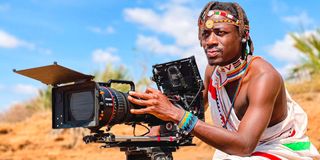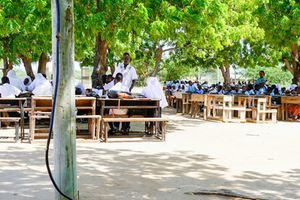Manu Akatsa, the award-winning filmmaker who loves to ‘shoot’ wildlife

Manu Akatsa is one of the recipients of the National Geographic Society Wayfinder Award for his work in wildlife cinematography.
Tension, excitement, adventure - this is what makes wildlife documentaries, and as we immerse ourselves in the unpredictable environment that makes up the wild, we are reminded that earth is not only home to human beings, but also to other species.
Manu Akatsa makes wildlife documentaries for living, and describes his work as a test of patience and a gameful of risks. As an award-winning documentary filmmaker with five years of experience, he has had the privilege to visit quite a number of game parks and reserves all over Africa to record natural history, which we get to enjoy in our living rooms.
“My recent trip to Gabon was sponsored by Nature Environment and Wildlife Filmmakers (NEWF). I met a lady earlier this year at the NEWF congress in Durban, (South Africa) and she kept talking about a film on gorillas that she wanted to make but did not know where to start. I offered to film it for free if she would pay for my accommodation and travel costs. We got RwandAir to sponsor my flight and off we went,” says Manu, whose latest high-profile award was from the National Geographic Society. He had never been to West Africa. His destination, Gabon, is largely rainforest, which makes it a suitable habitat for gorillas.
“We drove eight hours to Moukalaba-Doudou National Park. We were in a very remote area relying on a generator to power our batteries. It caught fire on the second day but I had carried spare batteries because you always have to be ready for anything.” They had no cellphone reception too, and relied on guides who had lived there for years. On his first day, he trekked for two hours in the rainforest while carrying heavy equipment.
“We would cross paths with elephants and safari ants would crawl up our pants, forcing us to strip to get them off and would cross rivers that were waist high. You have to trust these people (guides) that you have never met before to get you to and fro the destination in one piece. There is a lot of risk involved in this work,” he comments.
They finally got to the gorillas, but even after all that effort, had just one hour to get all the footage they needed because it is expensive to see them. Gorilla tours here cost about $500 (Sh70,000) to $1,000 (Sh140,000) per person for an hour. Manu explains that guides are some of the most important people in their expeditions. The gorillas he saw in Moukalaba-Doudou are wild but have been habituated to the guides, who interact with them using gorilla-like sounds. If it were not for the guides, Manu points out, he and his group would not have been able to film them, let alone be around them. Something seemingly as harmless as the flash of a camera or bright-coloured clothes would agitate them
Cat-and-mouse games
“Within that one hour, you are playing cat-and-mouse games trying to record the gorillas, which keep hiding behind the vegetation, and all you can see is a foot, an eye or their behind,” he says. It is during the last 10 minutes of the tour, that the group got to capture “an amazing moment” where a gorilla saw its reflection in the water and was trying to scoop it with its hand. For Manu, the long treks and risks he takes while filming are all worth it, just to experience such fleeting moments firsthand and get to document them for others to see. “I have gotten lost during night shoots in the Maasai Mara. When it gets dark, you lose sight of the beacons that guide you during the day, but thanks to technology, you are able to use trackers to find our way back home,” he comments.
Manu won the National Geographic Society 2023 Wayfinder award for his cinematography work that captures Earth’s beauty and complexity while highlighting the importance of preserving its rich natural and cultural heritage. He is one of 15 award recipients, who include an Egyptologist, a documentary filmmaker, investigative journalist, biologist and urban ecologist, who were selected for their achievements in exploration through science, education, conservation, technology, and storytelling.
“On behalf of the National Geographic Society, we’re proud to name these 15 trailblazers as 2023 Wayfinder Award recipients for their exceptional contributions on a local and global scale,” said Alexander Moen, chief explorer engagement officer at the National Geographic Society. Their groundbreaking work covers many impact-driven projects - using innovative technology to track insects across landscapes, investigating critical environmental stories, and developing equitable conservation solutions for poor communities.
Manu wishes to do more storytelling from the indigenous communities’ point of view through innovative technologies and interactive experiences. A life in the wild is one that he stumbled upon unexpectedly. Back in 2013, Manu was an animator. Even though his business was doing well, the monotony of a desk job was not fulfilling.
“I was in my 20s and I always wanted to travel and be embedded in nature. Without any prior training, a friend told me that a company called Wild Earth was looking for a cinematographer to stay in the Mara for two years. I just took a leap of faith since I had transferable skills and ended up being a perfect fit,” he says.
He packed up his bags in 2017 and travelled to the Mara for the first time, where he started his new job. As it turned out, he was the only Kenyan in the filming crew as most of the productions jetted in crews from other parts of the world due to the scarcity of Kenyan wildlife documentary filmmakers. “It was an easy decision to make. I was single back then and did not have children. We had a tented camp in the middle of the park to call home for two years. It was scary because lions, elephants, and snakes would wander into our camp, which had no fence. In the wild, you hear all kinds of sounds at night. Zebras would get hunted by predators and get mauled in front of our tents and we would wake up in the morning to find a carcass. You are really put out of your comfort zone,” he says.
Exciting experience
After that exciting experience, Manu found himself unemployed in 2019 following a restructuring, but in an unexpected turn of events, the pandemic that followed in 2020 offered him an unexpected opportunity.
“Since air travel was restricted, production companies had to use local filmmakers to go out and document the wildlife in their countries,” he says.
That is when Manu decided that he would make documentary filmmaking his career. It eventually paid off. Some of his work can be seen on Netflix’s Our Great National Parks, voiced by Former US President Barack Obama, who talks about his connection with Kenya in the third episode, which is filmed in Tsavo National Park.
“When I get to see my work on television, I am so happy. Sometimes, it can be as short as one to three minutes but it is still worth it.” He explains that most wildlife documentaries follow different storylines to keep it interesting, so there would be many different crews working on one show in different parts of the world.
“Every day will not be the same. Some days you will not get the shot or scene that you want, but on other days it will even exceed your expectations. There is no formula. That is how nature is. Unpredictable. You just have to take it as it is. We cannot interfere with anything. If we see an animal or its young ones being attacked, we don’t do anything about it,” he says.
In a documentary called Queens by Disneynature and Wildstar Films that is yet to be released, Manu says that they followed and documented the lives of mother figures in the animal kingdom, one of them was a cheetah with five cubs. “Every morning, we would go to her hiding spot to film. At some point, she would then go out to hunt, leaving her cubs vulnerable. One day, a leopard appeared and we watched it go up the hill to the hiding spot. Just as it was about to pounce on the cubs, the mother appeared and chased it away,” he narrates, excitement in his voice. The ‘circle of life’ , he says, can be brutal, and refers to watching the great wildebeest migration, which attracts a remarkable number of tourists to the Serengeti and Maasai Mara parks. In cases where the action is not readily available, Manu says one has to learn how to be patient.
Manu says that wildlife documentary makers often use hides when shooting to camouflage themselves, to avoid scaring off the animals and to enable them capture them in their natural element. He explains that a hide would ideally be the size of a car and the photographer or videographer would have to sit underneathe it from early morning with food, drinks and a couple of empty bottles for when they need to answer the call of nature.
“It can be exhausting since you have to be constantly attentive to capture what is happenin, but at the same time, you are in this quiet place with natural sounds, which can be very therapeutic.”
More of Manu’s work is seen in an episode of The Earthshot Prize, voiced by Sir David Attenborough, an English broadcaster, where they talk to people from the Maasai community who have benefited from tourism and conservation of national parks. The show is produced by the BBC and Silverback Films and was founded by Prince William to tell the stories of people around the world who are finding solutions to environmental challenges. Clips of flamingos in Kenya on an episode of Spectacular Earth on BBC Science show more of what Manu describes as his ‘appreciation of natural history.’





